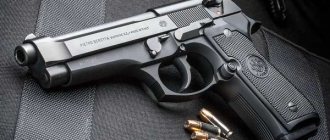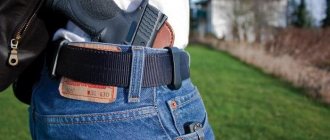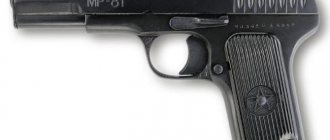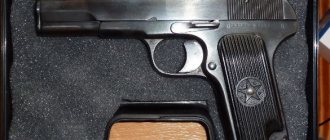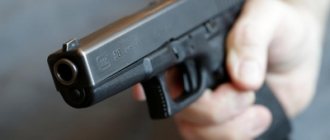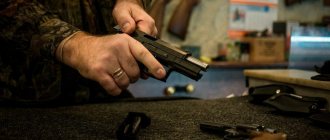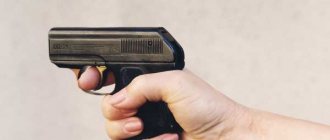Osa - traumatic pistol cartridge, caliber. Device
PB-4 “Osa”, a barrelless traumatic pistol, was developed by the Research Institute of Applied Chemistry (Sergiev Posad) in the mid-1990s as a civilian self-defense weapon. The chief designer of the new weapon complex was G.A. Bideev. When developing the complex, the task was to create an effective self-defense weapon that does not conflict with existing legal requirements.
Advantages and disadvantages of the model
Accuracy of fire. This makes it easier to use for the inexperienced shooter
High power. The bullet flies out with an energy of up to 90 Joules
Affordable price
Large selection of cartridges
Large thickness, this almost eliminates the concealed carrying of a pistol
The weapon is vulnerable to high humidity because it contains an electronic board
There is no safety (but the force required to pull the trigger is quite large)
Permission required for purchase
Pistol Wasp - video
To ensure the required level of effectiveness, it was first necessary to develop a new ammunition. The traumatic effect of a massive and relatively large-caliber rubber bullet, as well as a light-sound shock effect, causing disorientation of the attacker in space for some time, were chosen as mechanisms of influence on the target (NII PH is the main developer of light-sound “non-lethal” ammunition for domestic law enforcement agencies ). To exclude the possibility of using live cartridges in new self-defense weapons, as well as to make it as difficult as possible for users to independently reload cartridges, a “cartridge-barrel” scheme with electric ignition was chosen. With this design, the cartridge has a thick-walled sleeve of considerable length, while the bullet is completely recessed in the sleeve.
Pistol "Osa" PB-4-1
When fired, the front part of the cartridge serves as a short barrel, providing acceleration and direction of the bullet, and the chamber of the weapon only holds the cartridge in the desired position; The Wasp does not have a barrel as an element of a weapon, which is where the classification “barrelless self-defense weapon” comes from. To provide the necessary ballistics, as well as to make it difficult to reload cartridges, they have an unusual design - an aluminum cup is inserted inside the cartridge case itself, in which a powder charge and an electric capsule are located. The tail of the bullet enters the front of the cup, and the muzzle of the cup is compressed. This solution increases the boost pressure when firing, and also makes it difficult to remove the bullet without firing. Additionally, the design of the cartridge designed by NIIPH provides for the destruction of the electric primer when attempting to remove the bullet from the cartridge case without firing.
The PB-4 Osa self-defense weapon cartridges, which originally appeared in 1997, were equipped with a rubber bullet with a steel core (necessary to increase the mass of the bullet and its detection by an X-ray machine in case of penetrating wounds), which had a mass of about 8 grams and a muzzle energy of 110-120 Joules. In 2001, the energy characteristics of cartridges for PB-4 were reduced to the level of 80-85 Joules, with an increase in bullet weight to 11.6 grams; These characteristics remain such to this day. In addition to cartridges with a rubber bullet for the barrelless traumatic pistol Osa PB-4, NIIPH developed light and sound cartridges that affect attackers with a bright flash and a deafening roar of a shot. In addition, signal cartridges for giving red, yellow or green light signals, and lighting cartridges are produced for PB-4.
The Osa PB-4-1ML pistol is the most widely produced weapon model of the OSA complex chambered for 18x45 caliber. Made from special high-strength aluminum alloy. The pistol uses a “smart” system for determining the validity of the cartridge, which, if a malfunction is detected, sends a current pulse to the next working cartridge.
The PB-4 traumatic pistols themselves have gone through four major modifications, or generations. The first generation Osa PB-4 pistols had a mechanical barrel selector and power supply for the cartridge ignition circuit from a magnetic pulse generator (MIG). The Osa PB-4M traumatic pistols, which appeared in 2000, received a “smart” electronic circuit for selecting the firing barrel. This circuit uses the property of the electric primer of the 18x45 cartridge to pass a weak electric current when the cartridge is ready to fire, and not to pass the current at all after the cartridge has fired (the nichrome igniter wire in the capsule burns out). When you press the trigger, the electronic circuit uses a small current to check the serviceability of the primer of the first cartridge in the firing order in a very short period of time, and if it is working, it fires a shot, applying full current to the capsule.
If the first cartridge has already been fired or is missing from the chamber, the circuit automatically polls the second chamber. If the second chamber is also not ready, the third, and if necessary, the fourth chamber is interrogated. Thus, in the event of a misfire (malfunction, absence) of one cartridge, the pistol itself will fire the next working cartridge without the need to press the trigger again. The delay for polling cartridges is extremely short and the shooter does not notice it when firing, even if the fourth barrel in order is firing. This scheme was retained in subsequent generations of self-defense weapons - the Osa PB-4 traumatic pistols. Externally, the PB-4M traumatic pistol differs from the PB-4 in the absence of a window for a mechanical indicator of the firing cartridge on the left side of the handle.
Pistol "Osa" PB-4-2
The third generation of the Osa barrelless self-defense weapon, which appeared in 2003, is represented by the Osa PB-4-1 pistols. They received an improved handle, more comfortable to hold, but the most important changes were the introduction of a laser target designator (it is located in the handle of the weapon, the beam passes through a channel in the center of the chamber block) and the replacement of the magnetic pulse trigger generator with a lithium battery, which provides power as a trigger circuit and laser. Today, the most modern representatives of this type of self-defense weapon are the 4th generation traumatic pistols Osa PB-4-1 ML (appeared in 2005), in which the power of the laser and the trigger mechanism are separated - the laser designator is still powered by a battery, while the trigger mechanism is powered by a magnetic pulse trigger generator.
In addition to the above-mentioned modifications of self-defense weapons - the barrelless traumatic pistol "Osa", developed specifically as a civilian self-defense weapon, the Scientific Research Institute of Personal Defense also developed special modifications of the PB-4 pistol for law enforcement services and the armed forces. This is a “military” barrelless traumatic pistol PB-4V (version PB-4M, distinguished by sights and a swivel for a pistol belt; adopted for service in 2002 under the symbol GRAU 6P56) chambered for ordinary, “civilian” cartridges 18x45 and a “police” barrelless pistol PB-4-2 for extended and reinforced 18.5x70 cartridges with a muzzle energy of about 100 Joules. These samples are not put into civilian circulation.
The PB-2 "EGIDA" pistol is a compact two-shot barrelless pistol chambered for 18x45 caliber cartridge, the body of which is made of high-strength plastic.
The barrelless traumatic pistol Osa PB-4-1 ML is a four-shot weapon with a pairwise arrangement of four chambers in a single block made of aluminum alloy. The function of the barrels is performed by cartridge cases. The chamber block in its lower rear part is hingedly connected to the weapon frame, made of impact-resistant plastic. In the upper part of the chamber block there is a steel strip that provides reliable adhesion to the block lock, made in the upper part of the weapon frame. To reload, the chamber block is tilted down and forward, while the cartridges are partially pulled out of the chambers under the influence of a spring-loaded central extractor. The cartridges are removed manually, one at a time, and the chamber is loaded one cartridge at a time. The electronic trigger mechanism is powered by a magnetic pulse trigger generator, which receives energy from pressing the trigger. There are no additional manual or automatic devices to protect against accidental shooting.
The pistol grip contains a CR-123 lithium battery that powers a laser designator located at the end of the weapon frame, between the contact pads of the chambers. The laser pointer switch is located on the left side of the weapon frame, above the pistol grip. In addition to the laser center, the barrelless traumatic pistol Osa PB-4-1 ML is equipped with a rudimentary open sight, which looks like a U-shaped channel on the upper surface of the chamber block and a small, white-painted front sight in the front of this channel. The author of these lines has owned the Osa-PB-4-1 ML self-defense weapon since 2005. During this period, as part of training and test firing, over 300 rounds of 18x45 caliber were used, mostly with a rubber bullet (as well as a small amount of light-sound and signal ones).
The M-09 traumatic pistol is a further development of the OSA family of pistols. A distinctive feature of this pistol from its predecessors is its larger caliber and new ammunition. This pistol uses a high-efficiency traumatic cartridge 18.5x55TD
Considering the significant cost of cartridges for the Wasp, the cost of ammunition was already several times higher than the original cost of the weapon itself, while during the firing there was not a single delay or misfire due to the fault of the weapon. The main way to carry it in the cold season is an operational holster on a belt under outerwear; in the warm season, a belt bag-holster that can be worn openly, over a light shirt or T-shirt. The equipment of the pistol, depending on the circumstances, is selected either as 4 cartridges with a rubber bullet, or as a light and sound cartridge in the first chamber plus three cartridges with a rubber bullet. The second option of equipment is most often used in cases of trips to the park, to the countryside - where encounters with freely walking aggressive dogs are possible.
Fortunately, until now the author has never had to use this self-defense weapon to kill a real target, however, his own experiments with shooting a light-sound cartridge in the dark allow him to conclude that it is quite effective - the main thing is for the shooter to remember to close his eyes tightly moment of the shot or turn your head away. The advantages of the PB-4 Osa pistol include its good reliability, ease of use, large caliber, which provides good energy for each shot. Disadvantages can be considered the significant thickness of the weapon and small ammunition load.
The PB-4-3 "Compact" pistol chambered for the 15x40 caliber cartridge is distinguished by its small dimensions and high ammunition efficiency. The green target designator significantly increases the visibility of the aiming point at any time of the day and at any background brightness. The built-in illumination system allows you to temporarily blind and disorient the attacker with a light spot.
Options and modifications
PB-2 "Egida" - a two-shot version chambered for 18x45 mm, production began in 2006.
PB-4 "OSA" - a four-shot model chambered for 18x45 mm, production began in 1999 (discontinued).
PB-4M is a four-shot model chambered for 18×45 mm, production began in the fall of 2002 (discontinued).
PB-4V (GRAU index - 6P56) - a four-shot model chambered for 18x45 mm, an army version of the PB-4M, officially adopted for service in 2002. It differs from the PB-4M by the presence of a swivel on the base of the handle.
PB-4-1 is a four-shot model chambered for 18×45 mm cartridge.
PB-4-1ML - a four-shot model chambered for 18x45 mm with a laser designator, production began in mid-2003.
PB-4-2 is a four-shot model chambered for the 18.5×55 mm cartridge, with a slightly lengthened barrel block and a modified sighting device - consisting of a rear sight and a front sight.
PB-4SP is a four-shot model chambered for 18.5x60 mm cartridge, intended for arming certain categories of law enforcement officers. Adopted by the Ministry of Internal Affairs of the Russian Federation in 2005, it entered service with the Moscow riot police. In September 2007, the Ministry of Internal Affairs of the Russian Federation also adopted 18.5x60 mm signal and lighting cartridges. A certain number of these pistols entered service with certain units of the patrol service and transport police in 2008; in 2012, another 3,827 pistols and 43 thousand cartridges for them were purchased for the police. In June 2013, another 919 units. purchased for military police.
The OSA Flare Gun is a four-shot model with an orange plastic body.
PB-4-3 “Compact” is a four-shot model chambered for 15x40 mm cartridge.
M-9 is a four-shot model chambered for 18.5x55 mm. It has either a green or red (in a cheaper version) laser laser. A distinctive feature is a special sensor that turns on the laser center automatically when you wrap your hand around the handle.
Ammo
For firing from the Osa complex, traumatic, lighting, signal, light-sound and gas cartridges are used. In addition to the letter index on the cartridge marking, to determine the type of cartridge in the dark tactilely (by touch), the cartridge wads have protrusions. The initial velocity and muzzle energy of a traumatic cartridge bullet may vary slightly depending on the batch of cartridges. There are known cases of fatal wounds caused by a bullet hitting the head at a short distance.
Disassembly and repair of OCA
Despite the fact that the developers have done everything to ensure that Osa pistols are called the most reliable, they still have drawbacks. For starters, these are the contacts that supply current to the ammunition primer. Water, temperature changes, dust, all this negatively affects the metal. The formation of an oxide film creates resistance, as a result of which a shot will not fire if the weapon and ammunition are operational.
But this is easy to avoid; you need to periodically wipe the contacts with alcohol. Cleaning with alcohol is a recommendation for any Osa models. But there are also more subtle nuances to maintaining the functionality of pistols. For example, you can consider the PB-4-1ML model, since many analogues are almost the same, except for certain details. The electrical circuit of the WASP looks like this.
A magnetic pulse generator is installed to power the electrical circuit; this device generates current when fired. After the pulse passes through the stabilizer D1, it equalizes the current. This is required so that the microcontroller does not burn out and breakdown in the diodes does not occur.
In addition, when the trigger is released, another pulse appears; when it is supplied according to the electrical circuit, the microcontroller necessarily breaks down, so the D1 stabilizer cuts it off. Afterwards, the pulse passes to capacitor C1, which in turn reduces it.
Thanks to diode D2, power is supplied to the microcontroller; it is also required to prevent resistor C1 from discharging when current is supplied to the ammunition capsule. Elements R1 and C3 set the frequency of operation of the controller and affect the speed of checking cartridges before firing. It must be said that this chain is the weakest link in this circuit, since malfunctions are guaranteed when moisture enters.
The first problem is the incorrect determination of the performance of the ammunition. It’s just that the weapon itself determines this by its resistance; the operating range is 1-1600 Ohms. That is, if the owner of the pistol did not take care of it, then the contacts oxidize and the ammunition is recognized by the system as inoperative.
This problem can be solved in several ways.
- The first is periodic cleaning of weapons.
- The second is making changes to the controller program, which is difficult to do on your own, so you can skip the last method.
This flaw is not found in all models, it depends on the production series, but it is difficult to clearly determine pistols that are susceptible to this “disease”, however, you can test your weapon with several shots of test cartridges.
It must be said that flashing the processor will save the weapon from jamming on the first oxidized ammunition, but another problem will arise, it also occurs in models with old firmware.
Four-shot models have different cartridge options. For example, the first two are loaded with light-sound ammunition in order to avoid causing serious injury when using a pistol, the latter remain only as a last resort. And so the light and sound cartridges were shot and, returning home, they were reloaded. But the next time you use it, an unexpected surprise will await you, as a traumatic cartridge will fire. Why does this happen?
Having fired the first two rounds of ammunition, the weapon remembers that they are not there, and checks the chambers of cartridges 1 and 2 when it has already fired bullets 3 and 4. To reset the settings, you need to pull the trigger with the cassette removed.
Another weak point in Osa models is the magnetic pulse generator. The problem is that after 7-8 years the generator can no longer produce current because the magnet inside the MIG has weakened. To be sure that the problem is in the generator, you need to pull the trigger and feel how hard it is pressed as before, if so, then the problem is in the MIG. You can fix this problem yourself.
First, you need old non-working speakers from a smartphone, or you can simply buy them. You will need four speakers, preferably from the same phone model.
We disassemble the weapon and look for the MIG. This is a cylinder with two cords coming out of it, and a button closed with a rubberized plug. Carefully roll it out and take out the insides. Taking out the magnet, you can see that it is the same as in the phone speakers, the only difference is in thickness.
We disassemble the four speakers to remove the magnetic rings and connect the latter together. This creates a single magnet the same as the factory one, we put it in place of the old one and assemble the gun in the reverse order. We shoot test cartridges that look like the photo below.
More details about disassembling the Osa pistol can be seen in the following video
Photo of the Osa pistol
Similar
AK-47 assault rifle cartridge caliber 7.62 mm.
Device. Rate of fire AK-74 assault rifle cartridge 5.45 mm caliber. Device. Rate of fire
Dragunov SVD sniper rifle caliber 7.62 mm. Device
AKS-74U assault rifle cartridge caliber 5.45 mm. Device. Weight
Mauser K96 pistol cartridge caliber 7.63 and 9 mm. Device
Pistol Walter PP / PPK cartridge caliber 7.65 and 9 mm. Device
Pistol Yarygin PYa Grach cartridge caliber 9 mm. Device
DShK machine gun cartridge caliber 12.7 mm. Device. Rate of fire
Luger pistol R.08 Parabellum cartridge caliber 9 mm. Device
Pistol PM cartridge caliber 9 mm. Rate of fire. Dimensions. Bullet speed. Sighting range
Self-loading shotgun Saiga-12 cartridge, caliber. Device
Maxim machine gun cartridge caliber 7.62 mm. Device. Weight
PPSh-41 Shpagina submachine gun cartridge caliber 7.62 mm
APS Stechkin pistol cartridge caliber 9 mm. Device
Nagan system revolver cartridge caliber 7.62 mm. Device
Kalashnikov PK machine gun and PKM cartridge caliber 7.62 mm. Device
Simonov carbine SKS-45 cartridge caliber 7.62 mm. Device
Rifles and carbines Mauser 98 caliber 7.92 mm. Device
PPS-42 and PPS-43 Sudaev submachine gun cartridge caliber 7.62 mm
Pistol Walter P38 cartridge caliber 9 mm. Device
MP-40 German submachine gun cartridge caliber 9 mm. Device
VSS Vintorez sniper rifle caliber 9 mm. Device
Submachine gun PP-91 Kedr cartridge 9 mm caliber. Device
Light machine gun RPK-74 cartridge caliber 5.45 mm. Device
Pistol Glock 17 cartridge caliber 9 mm. Device
Makarych, Izh-79-9T, MR-79-9TM, MP-80-13T traumatic pistol
AK-12 assault rifle cartridge caliber 5.45 mm. Device. Weight
Mosin rifles and carbines Three-line caliber 7.62 mm
PMM Makarov pistol modernized 12 rounds. Device
Revolver Colt Single Action Army (SAA) Peacemaker. Device
Machine gun PKP Pecheneg cartridge caliber 7.62 mm. Device
Sniper rifle VSSK Exhaust caliber 12.7 mm. Device
Beretta pistol 92 cartridge caliber 9 mm. Device
TT - Tokarev pistol cartridge caliber 7.62 mm. Device
Submachine gun PP-19 Bison cartridge caliber 9 and 7.62 mm. Device
Sniper rifle SV-98 caliber 7.62 mm. Device
Vladimirov KPV machine gun cartridge caliber 14.5 mm. Device
ASH-12 assault rifle cartridge caliber 12.7 mm. Device. Rate of fire
PSM pistol cartridge caliber 5.45 mm. Device
Pistol Colt M1911A1 cartridge caliber 45. Device
Smith-Wesson revolver Russian cartridge, caliber 10.67 mm. Device
Degtyarev DP-27 light machine gun, 7.62 mm caliber cartridge. Device
Shotgun Mossberg 500 Cartridge. Dimensions. Rate of fire. Sighting range
Thompson submachine gun cartridge caliber 11.43 mm. Device
Pistol USP Heckler und Koch cartridge, caliber. Device
Hunting carbine OSK-88 (SVT-40) caliber 7.62 mm. Device
AS Val silent automatic cartridge caliber 9 mm. Device
Submachine gun PP-19-01 Vityaz cartridge 9 mm caliber. Device
Machine gun Kord cartridge caliber 12.7 mm. Device. Weight. Sighting range
Osa - traumatic pistol cartridge, caliber. Device
AK-9 assault rifle cartridge caliber 9 mm. Device. Rate of fire
Degtyarev RPD light machine gun, 7.62 mm caliber cartridge. Device
Automatic OTs-14 Groza cartridge caliber 9 mm and 7.62 mm. Device
Czech pistol CZ-75 (modifications). Device
Browning pistol 1903 cartridge caliber 9 mm. Device
Sniper rifle OSV-96 caliber 12.7 mm. Device
FN P90 submachine gun cartridge caliber 5.7 mm. Device
Submachine gun OTs-02 Cypress cartridge caliber 9 mm. Device
Sniper rifle ASVK Kord caliber 12.7 mm. Device
Automatic AEK-971 Cartridge. Caliber. Device. Rate of fire
Steyr AUG assault rifle (A1, A2, A3) cartridge caliber 5.56 mm
AK series 100 assault rifles. Modifications. Device. Weight. Dimensions
Uzi submachine gun. Cartridge. Caliber. Rate of fire
Pistol SR1M Gyurza cartridge caliber 9 mm. Device
Pistol GSh-18 cartridge caliber 9 mm. Device
SVDK sniper rifle caliber 9.3 mm. Device
Automatic SR-3M Whirlwind cartridge caliber 9 mm. Device
Machine gun NSV-12.7 Utes cartridge, cal. Device. Weight
Kalashnikov RPK light machine gun cartridge caliber 7.62 mm. Device
Sniper rifle VSK-94 caliber 9 mm. Device
Vostok-1 (Jorge-3M) 9mm caliber traumatic pistol. Device
Degtyarev PPD submachine gun cartridge caliber 7.62 mm
English sniper rifle L96A1 cartridge, caliber
M1 Garand rifle cartridge caliber 7.62 mm. Device
Desert Eagle pistol. Device
Smith-Wesson revolver (modifications). Device
Automatic rifle HK G36 (E, K, C, KE) cartridge caliber 5.56 mm
Pistol P-96 cartridge caliber 9 mm. Device. Rate of fire
Pistol GP35 Browning High Power cartridge, caliber. Device
Assault rifle FN SCAR (L, H) cartridge caliber 5.56 and 7.62 mm
Revolver Lefoshe M1856 cartridge caliber 11 mm. Device
Submachine gun PP-90 cartridge caliber 9 mm. Device
AN-94 Abakan automatic Nikonov cartridge caliber 5.45 mm. Device
Submachine gun PP-2000 cartridge caliber 9 mm. Device
Mauser pistol HSc cartridge caliber 7.65 and 9 mm. Device
M16 automatic rifle cartridge caliber 5.56 mm. Device
Fedorov assault rifle cartridge caliber 6.5 mm. Device. Rate of fire
Pistol Baltiets cartridge caliber 7.62 mm. Device
Strizh pistol cartridge caliber 9 mm. Device. Weight. Sighting range
Browning pistol 1910 cartridge caliber 7.65 and 9 mm
Silent pistol PSS Vul cartridge caliber 7.62 mm. Device
Pistol SIG-Sauer P226 cartridge caliber 9 mm. Device
Pistol OTs-27 Berdysh cartridge caliber 7.62 mm and 9 mm. Device
AK-107 assault rifle cartridge caliber 5.45 mm. Device. Rate of fire
OTs-44 sniper rifle, caliber 12.7 mm. Device
German machine gun MG3 cartridge caliber 7.62 mm. Device
Self-loading shotgun Browning Auto-5 cartridge, caliber. Device
Submachine gun AEK-919K Kashtan cartridge caliber 9 mm. Device
PB pistol silent cartridge 9 mm caliber. Device
Pistol OTs-33 Pernach cartridge caliber 9 mm. Device
Hunting carbine KO-98 cartridge caliber 7.92 mm. Device
TK (Korovin pistol) caliber 6.35 mm. Device. Weight. Dimensions
Underwater assault rifle APS cartridge caliber 5.66 mm. Device
Pistol OTs-21 Malysh cartridge caliber 9 mm. Device
American M60 machine gun, 7.62 mm caliber cartridge. Device
MTs-116M sniper rifle, caliber 7.62 mm. Device
Automatic 9A-91 cartridge caliber 9 mm. Device. Rate of fire
Submachine gun PP-93 cartridge caliber 9 mm. Device
VAG-73 - Gerasimenko pistol. Device. Weight. Dimensions
Cordon-5 is a traumatic pistol. Device. Weight. Dimensions
Goryunov SG-43 heavy machine gun cartridge caliber 7.62 mm. Device
Webley revolver cartridge, caliber. Device. Dimensions. Weight
Machine gun AEK-999 Badger cartridge caliber 7.62 mm. Device
RP-46 machine gun, 7.62 mm caliber cartridge. Device. Rate of fire
Sniper rifle VS-8 cartridge caliber 8.6 mm. Device
Slostin machine gun cartridge caliber 7.62 mm and 14.5 mm. Device
Assault rifle Tavor TAR-21 cartridge caliber 5.56 and 5.45 mm
Submachine gun SR-2 Veresk cartridge caliber 9 mm. Device
Lancaster pistol cartridge caliber 12.1 mm. Device. Rate of fire
Submachine gun PP-90M1 cartridge caliber 9 mm. Device
Underwater pistol SPP-1M. Device. Weight. Dimensions
Traumatic pistol MP-461 Guard. Device. Weight. Dimensions
Lebel rifles and carbines are cartridgeed in 8 mm caliber. Device
Automatic A-91 cartridge caliber 7.62 mm. Device. Rate of fire
M14 automatic rifle cartridge caliber 7.62 mm. Device
Revolver Smith & Wesson Model 10 Military & Police
Automatic rifle FN FAL cartridge caliber 7.62 mm. Device
Submachine gun STEN MK 2. Device. Weight. Dimensions
Traumatic pistol IZH-78-9T Chain mail cartridge caliber 9 mm
Leader-M traumatic pistol 11.43×32T. Device. Weight. Dimensions
Ingram M10 and M11 submachine gun. Device. Weight. Dimensions
Pistol Steyr M9-A1 cartridge caliber 9 mm. Device. Weight
Pistol OTs-23 Dart cartridge caliber 5.45 mm. Device
Berthier rifles and carbines caliber 8 mm. Device
Automatic shotgun USAS-12 cartridge caliber 18.5 mm
Sniper rifle VS-121 caliber 7.62 mm. Device
Traumatic pistol MP-353 cartridge, caliber 11.43 mm
Tiss machine gun cartridge caliber 9 mm. Device. Rate of fire
Traumatic pistol MP-355 cartridge caliber 9 mm. Device
Automatic double-medium ADS cartridge caliber 5.45 mm. Device. Rate of fire
Traumatic pistol MP-81 cartridge caliber 9 mm. Device
Pistols Zastava 70 and 70(k), cartridge caliber 7.65 or 9 mm. Yugoslavia
Sniper rifle GALATZ (Galil) cartridge caliber 7.62 mm
Pistol MP-444 Bagheera cartridge caliber 9 mm. Device
Revolver Colt New Army / Navy. Device. Bullet speed. Sighting range
Type 64 is a Japanese automatic rifle. Device
Comments
0 Xandr81 01/26/2017 09:30 These weapons entered service with American cops in the state of Arizona. Well, they are also already used by law enforcement officers in Germany, Switzerland, Israel, the Czech Republic, South Africa, the UAE, Belarus, Kazakhstan and Armenia...
Reply | Reply with quote | Quote
0 kolyantus 01/26/2017 09:48 buying this terrible weapon ceased to make sense in 2014 when the wasp was burned off its only plus, power. The cartridges have become very cheap and the cost of each cartridge remains sky-high. the wasp now does not have a single advantage even compared to the shark
Reply | Reply with quote | Quote
0 WMuckaMW 01/26/2017 09:51 I had the idea to lengthen the cassette, let’s say, and cast it from bronze or aluminum, although it can also be made from stainless steel, if you double the size, increase the barrel, it will probably be an even more lethal thing)
Reply | Reply with quote | Quote
0 Gunsmith 01/26/2017 09:53 Quoting WMuckaMW:
I had an idea to lengthen the cassette, let’s say, and cast it out of bronze or aluminum, although it can also be made of stainless steel, if you double it, you’ll build up the barrel, it’ll probably be even more lethal)
Games with the law, however, may not be understood) The frame itself is not designed for high returns (Although even in the USA, where in almost all states, almost everything can be legally purchased, including heavy weapons, some homemade people are making something Reply | Reply with a quote | Quote
0 Anton 01/26/2017 09:54 If this gun is electric, does it need to be charged?
Reply | Reply with quote | Quote
0 Gunsmith 01/26/2017 09:55 I quote Anton:
If this gun is electric, does it need to be charged?
Let's just say that the ancient Wasps could have had a very diverse food system.
It is in this model that each time the shutter is pressed, electricity is generated. impulse and a shot occurs. You don't need to charge anything. The only thing is to change the battery on the laser center. Reply | Reply with quote | Quote 0 Kromater 01/26/2017 09:57 The developers tried, they managed to certify the OSU without a fuse, and you immediately “minus”! The absence of a safety lock is a plus of the WASP, as well as the absence of moving elements such as a bolt, etc., because in self-defense the main thing is the ability to fire a shot without any additional manipulations. And a heavy trigger, 3-4 kg/cm2, is used as a fuse.
Reply | Reply with quote | Quote
0 Gunsmith 01/26/2017 09:58 I quote Kromater:
The developers tried hard and managed to certify the OSU without a fuse, but you immediately got a “minus”! The absence of a safety lock is a plus of the WASP, as well as the absence of moving elements such as a bolt, etc., because in self-defense the main thing is the ability to fire a shot without any additional manipulations. And a heavy trigger, 3-4 kg/cm2, is used as a fuse.
I understand you perfectly, by some miracle I passed certification without protection.
Usually EM-VE-DE forces you to install non-automatic ones on fenced short barrels for IPSC. But unfortunately, there are quite a lot of cases of unintentional crossbows, incl. children. When I show the Osa to my friends, I ALWAYS unload it, because every single one of their fingers immediately goes to the trigger Reply | Reply with quote | Quote 0 Mr77999 01/26/2017 10:01 The absence of a safety lock is a plus, take it out and shoot, there are no unnecessary manipulations.
Reply | Reply with quote | Quote
0 Gunsmith 01/26/2017 10:01 am Quoting Mr77999:
The lack of a safety lock is a plus; take it out and shoot, there are no unnecessary manipulations.
Personally, I like non-automatic fuses - whether you want to use them or not.
Those of them that, in addition to blocking the trigger or sear, block nothing. Or automatic, those that turn off when you put your hand on the handle. (Like on a Glock) Reply | Reply with quote | Quote 0 krisuko 01/26/2017 10:07 I had a wasp with cartridges lounging in the lake for 2 days, at a depth of about a meter and a half. The boat was capsized near the shore. When we sobered up, we went and found her. They immediately took out the battery and dried it somehow. All the cartridges fired and the wasp did not die, strangely enough.
Reply | Reply with quote | Quote
Update list of comments
